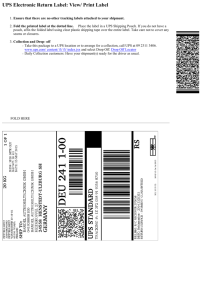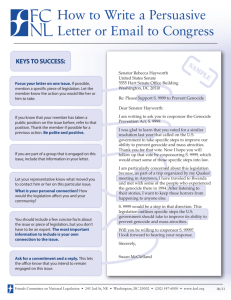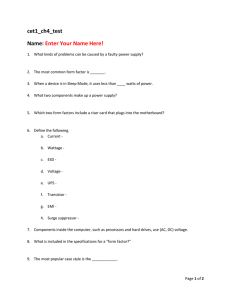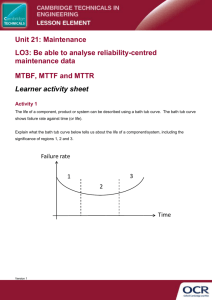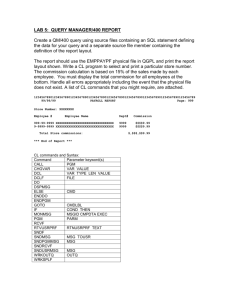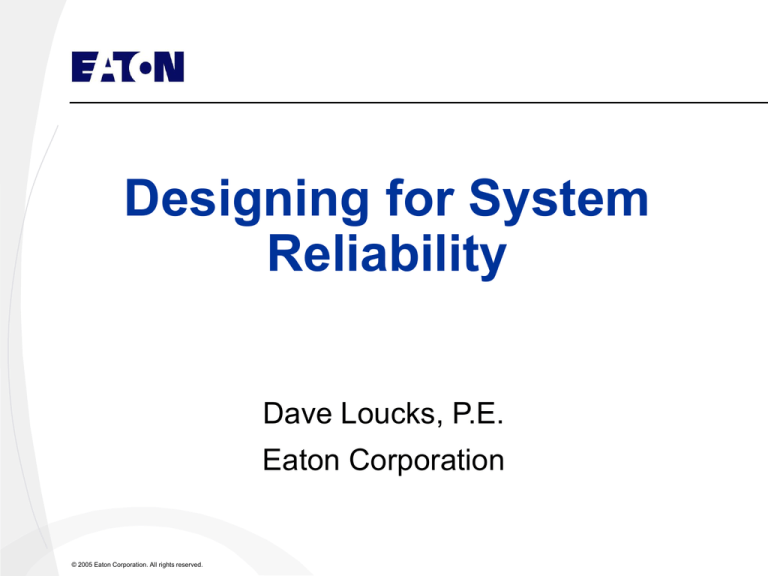
Designing for System
Reliability
Dave Loucks, P.E.
Eaton Corporation
© 2005 Eaton Corporation. All rights reserved.
To
Facility
From
Main
To UPS
To UPS
From Emergency Bus
From Distribution Bus
What Reliability Is Seen At The
Load?
For example, if power flows to load as below:
Assume outage duration exceeds battery capacity
Utility
UPS
Breaker
Load
Series Components
For example, if power flows to load as below:
Assume outage duration exceeds battery capacity
Utility
UPS
Breaker
99.9%
99.99%
99.99%
Load
Series Components
For example, if power flows to load as below:
Assume outage duration exceeds battery capacity
Utility
99.9%
(8.7 hr/yr)
UPS
Load
Breaker
x
99.99%
x
99.99%
+ (0.87 hr/yr) + (0.87 hr/yr)
=
=
99.88%
(10.5 hr/yr)
Overall reliability is poorer than any component
reliability
Series Components
For example, if power flows to load as below:
Assume outage duration exceeds battery capacity
Utility
UPS
99.9%
x
99.99%
x
99.99%
(8.7 hr/yr) + (0.87 hr/yr) + (0.87 hr/yr)
PF* = 0.1% +
0.01%
+
0.01%
* PF = probability of failure
Load
Breaker
PF = (1 – Reliability) = 1 – R(t)
=
=
=
99.88%
(10.5 hr/yr)
0.12%
Series Components
For example, if power flows to load as below:
If outage duration less than battery capacity
UPS
Load
Breaker
99.99%
x
99.99%
(0.87 hr/yr) + (0.87 hr/yr)
PF = 0.01%
+
0.01%
=
=
=
99.98%
(1.74 hr/yr)
0.02%*
Batteries Depleted
99.88% reliable
Batteries Not Depleted
99.98% reliable
Parallel Components
What if power flows to load like this:
Assume outage duration exceeds battery capacity
UPS
Static
ATS
Utility
UPS
Load
Parallel Components
What if power flows to load like this:
Assume outage duration exceeds battery capacity
UPS
Utility
99.9%
99.99%
Static
ATS
UPS
99.99%
99.99%
Load
?? %
Parallel Components
What if power flows to load like this:
Assume outage duration exceeds battery capacity
UPS
Utility
99.9%
PF* = 0.1%
+
99.99%
Static
ATS
UPS
99.99%
99.99%
PF(a or b)
+
0.01% =
Load
?? %
?? %
Parallel Components
What if power flows to load like this:
Solve each path independently
UPSa
99.99%
UPSa
99.99 %
UPSb
99.99%
PF(a or b) =
99.99%
99.99 %
UPSb
0.01 %
99.99%
x
0.01% = 0.000001 %
R(t) = 1 - PF(a or b) = 99.999999%
Parallel Components
Multiply the two Probabilities of Failure, PF(a)
and PF(b) and subtract from 1
Utility
99.9%
UPSa
or
UPSb
Static
ATS
99.99%
Load
99.89 %
99.999999%
PF(total) = PF(u) + PF(a or b) + PF(s)
= 0.1% + 0.000001% + 0.01% = 0.110001%
Parallel Components
Multiply the two Probabilities of Failure, PF(a)
and PF(b) and subtract from 1
UPSa
or
UPSb
Static
ATS
99.99%
99.999999%
PF(total) = PF(a or b) + PF(s)
= 0.000001% + 0.01% = 0.010001%
Load
99.99 %
Summary Table
Configuration
Reliability
Single UPS system (long term outage)
99.88%
Single UPS system (short term outage)
99.98%
Redundant UPS system (long term outage)
99.89%
Redundant UPS system (short term outage)
99.99%
Comments?
Value Analysis
Is going from this:
Utility
UPS
Breaker
99.88%
(only battery) 99.89%
to this
0.01%
difference
UPS
Static
ATS
Utility
UPS
worth it?
99.89%
(only battery) 99.99%
Availability
MTBF
Ai
100 %
MTBF MTTR
Increase Mean Time Between Failures (MTBF)
Decrease Mean Time To Repair (MTTR)
MTBF (100 Ai )
MTTR
Ai
Relationship of MTBF and MTTR to
Availability
1
0.95
MTBF
Availability
0.9
0.85
0.8
0.75
0.7
0.65
0
10
20
30
40
50
60
MTTR (Hours)
70
80
90
100
95% Availability from Different
MTBF/MTTR combinations
1
0.95
MTBF
Availability
0.9
0.85
0.8
0.75
0.7
10.5
21.1
31.6
42.1
30
40
52.6
0.65
0
10
20
50
60
MTTR (Hours)
70
80
90
100
Breakeven Analysis
Total Economic Value (TEV)
Simple Return (no time value of money)
•
TEVS = (Annual Value of Solution x Years of Life of Solution) –
Cost of Solution
Assume an outage > 0.1s costs
$10000/yr
Assume cost of solution is
$30000
Assume life of solution is
10 years
Breakeven Analysis
Since solution eliminates this potential 0.41
second outage, we “save” $10000 each year
Total Economic Value (TEV)
Simple Return (no time value of money)
TEVS = (Annual Value of Solution x Years of Life of
Solution) – Cost of Solution
TEVS = (($10000 x 1) x 10) – $100000
TEVS = $100000 - $30000 = $70000
Let’s Examine a More Complex
System
Source 1
99.9%
99.99%
52
Source 2
99.9%
52
K
K
99.99%
99.999%
Source 1
99.9%
99.99%
Source 2
99.9%
52
52
99.999%
99.99%
99.999%
99.99%
99.99%
99.99%
99.999%
99.999%
99.99%
99.999%
99.99%
What is the
reliability
at this point?
Design 1
99.99%
What is the
reliability
at this point?
Design 2
Primary Selective
Source 1
99.9%
99.99%
52
Source 2
99.9%
52
K
K
Source 1
Source 2
.999 x
.9999 =
99.89%
.999 x
.9999 =
99.89%
99.99%
99.89%
99.999%
Convert to
99.99%
99.89%
99.999%
99.99%
99.999%
99.999%
99.99%
99.99%
What is the
reliability
at this point?
What is the
reliability
at this point?
Design 1
Combine Reliabilities:
Parallel Sources
Source 1
99.9%
99.99%
52
Source 2
99.9%
52
K
K
Source 1 or Source 2
PF1 x PF2 = PF both
PF both = 0.11% x 0.11%
PF both = 0.0121%
99.99%
99.999%
R(t) = 1 – PF both
= 100% - 0.0121%
= 99.99%
PF1 = 0.0121%
R(t) = 99.99%
99.999%
99.99%
99.99%
99.999%
99.999%
99.99%
99.99%
What is the
reliability
at this point?
What is the
reliability
at this point?
Design 1
Combine Reliabilities:
Parallel Sources + Tx + Sec. Bkr.
Source 1
99.9%
99.99%
52
Source 2
99.9%
52
K
K
Source 1 or Source 2
99.99%
Rsource x Rtx x Rmb = R(t)
= .9999 x .99999 x .9999
= .9998
99.999%
99.99%
99.999%
99.999%
R(t) = 99.98%
99.99%
99.99%
What is the
reliability
at this point?
What is the
reliability
at this point?
Design 1
Combine Reliabilities:
… + bus and feeder breaker
Source 1
99.9%
99.99%
52
Source 2
99.9%
52
K
K
Source 1 or Source 2
99.99%
99.999%
Rsource x Rtx x Rmb = R(t)
= .9998 x .99999 x .9999
= .99969
99.99%
99.999%
99.99%
What is the
reliability
at this point?
Design 1
R(t) = 99.969%
Secondary Selective
Source 1
99.9%
99.99%
Source 2
99.9%
52
52
99.999%
99.99%
99.999%
99.99%
99.99%
99.999%
99.999%
99.99%
99.99%
What is the
reliability
at this point?
Design 2
Secondary Selective
Source 1
99.9%
99.99%
Source 2
99.9%
52
52
99.999%
Source 1
99.99%
99.999%
99.99%
Source 2
R(t) = Rs x Rmb x Rtx x
Rsb
= .999 x .9999 x
.99999 x .9999
= .99879
R(t) = Rs x Rmb x Rtx x
Rsb
= .999 x .9999 x
.99999 x .9999
= .99879
99.99%
99.999%
99.999%
R(t) = 99.88%
99.99%
99.999%
99.88%
99.99%
99.99%
What is the
reliability
at this point?
Design 2
99.999%
99.99%
Secondary Selective
Source 1
99.9%
99.99%
Source 2
99.9%
52
52
99.999%
Source 1
99.99%
99.999%
99.99%
Source 2
R(t) = Rs x Rmb x Rtx x
Rsb
= .999 x .9999 x
.99999 x .9999
= .99879
R(t) = Rs x Rmb x Rtx x
Rsb
= .999 x .9999 x
.99999 x .9999
= .99879
99.99%
99.999%
99.999%
R(t) = 99.88%
99.99%
99.999%
99.99%
99.99%
What is the
reliability
at this point?
Design 2
99.999%
99.99%
Secondary Selective
Source 1
99.9%
99.99%
Source 2
99.9%
52
52
99.999%
Source 1
99.99%
99.999%
99.99%
Source 2
R(t) = Rs x Rmb x Rtx x
Rsb
= .999 x .9999 x
.99999 x .9999
= .99879
R(t) = Rs x Rmb x Rtx x
Rsb
= .999 x .9999 x
.99999 x .9999
= .99879
99.99%
99.999%
99.999%
99.99%
Rs1 = 99.879%
Rbus2 = 99.999%
Rbus1 = 99.999% R = 99.99%
tie
Rpath1 = Rs1 x Rbus1 x Rtie x Rbus2 x Rfdr
Rpath1 = .99879 x .99999 x .9999 x .99999 x .9999
Rpath1 = .99857
PF1 = 1 – Rpath1 = 1-.99857 = 0.00143 = 0.143%
Design 2
Rfdr =
99.99%
Secondary Selective
Source 1
99.9%
99.99%
Source 2
99.9%
52
52
99.999%
Source 1
99.99%
99.999%
99.99%
Source 2
R(t) = Rs x Rmb x Rtx x
Rsb
= .999 x .9999 x
.99999 x .9999
= .99879
R(t) = Rs x Rmb x Rtx x
Rsb
= .999 x .9999 x
.99999 x .9999
= .99879
99.99%
99.999%
99.999%
99.99%
Rs2 = 99.879%
Rbus2 = 99.999%
Rpath2 = Rs2 x Rbus2 x Rfdr
Rpath2 = .99879 x .99999 x .9999
Rpath2 = ..99868
PF2 = 1 – Rpath2 = 1-.99868 = 0.00132 = 0.132%
Design 2
Rfdr =
99.99%
Secondary Selective
Source 1
99.9%
99.99%
Source 2
99.9%
52
52
99.999%
Source 2
99.99%
99.999%
99.99%
Source 1
R(t) = 1 – (PF1 x PF2)
= 100% - (0.143% x 0.132%)
= 100% - (0.0189%)
= 99.981%
99.99%
99.999%
99.999%
99.99%
R(t) = 99.981%
Design 2
Comparison
Method
Reliability at Load
1. Primary Selective
99.969%
2. Secondary Selective
99.981%
Comments?
Value Analysis
1. 99.97% x 8760 = failure once every 8757 hours
2. 99.98% x 8760 = failure once every 8758 hours
Assuming 1 hour repair time, we will see two, 1hour outages after 8758 hours
Meaning 1/8758 hours (0.411 seconds) expected
outage per year
As with UPS example, what is 0.411 seconds
worth?
What is cost differential of higher reliability
solution?
Breakeven Analysis
Total Economic Value (TEV)
Simple Return (no time value of money)
•
TEVS = (Annual Value of Solution x Years of Life of Solution) –
Cost of Solution
Discounted Return (borrowed money has cost)
•
TEVD = (NPV(annual cash flow, project life, interest rate) –
Cost of Solution
Assume 0.411 sec of downtime costs $20000/yr
Assume cost of solution is
$75000
Assume life of solution is
10 years
Breakeven Analysis
Total Economic Value (TEV)
Simple Return (no time value of money)
TEVS = (Annual Value of Solution x Years of Life of
Solution) – Cost of Solution
TEVS = (($20000 x 1) x 10) – $200000
TEVS = $200000 - $75000 = $125000
Discounting cash flow at 10% cost of money
TEVD = NPV($20000/yr, 10 yrs, 10%) – $30000
TEVD = $122891 – $75000 = $47891
Solve for Equivalent Interest Rate
Knowing initial cost of
and annual benefit of
what is the equivalent return?
$75000
$20000
$75000
Year
0
$20000
$20000
$20000
$20000
$20000
$20000
$20000
$20000
$20000
$20000
Year
1
Year
2
Year
3
Year
4
Year
5
Year
6
Year
7
Year
8
Year
9
Year
10
Uniform Series Present Value
n=
P – Present Value
A – Annuity payment
n – Number of periods
i – Interest per period
Uniform Series Present Value
Equations
1 i n 1
PV A
i 1 i n
P – Present Value
A – Annuity payment
n – Number of periods
i – Interest per period
or
i 1 i n
A PV
1 i n 1
But what if PV, A and n are known and i is
unknown?
Iterative calculation
Uniform Series Present Value
Equations
1 i n 1
PV A
i 1 i n
n
i
PV
RS of Equation
Comment
10
5%
$75000
$154435
i too low
10
30%
$75000
$61831
i too high
10
20%
$75000
$83849
i too low
10
25%
$75000
$71410
i too high
10
23.413%
$75000
$75000
correct
value
Breakeven Analysis
Total Economic Value (TEV)
Simple Return (no time value of money)
TEVS = (Annual Value of Solution x Years of Life of
Solution) – Cost of Solution
TEVS = (($20000 x 1) x 10) – $200000
TEVS = $200000 - $75000 = $125000
Discounting cash flow at 10% cost of money
TEVD = NPV($20000/yr, 10 yrs, 10%) – $30000
TEVD = $122891 – $75000 = $47891
IRR = 23.413% effective return
Reliability Tools
Eaton Spreadsheet Tools
IEEE PCIC Reliability Calculator
Commercially Available Tools
Financial Tools (web calculators)
Web Based Financial Analysis
www.eatonelectrical.com
search for “calculators”
Choose “Life Extension
ROI Calculator”
Web Based Financial Analysis
Report provides financial
data
Provides Internal Rate of
Return
Use this to compare with
other projects competing
for same funds
Evaluates effects due to
taxes, depreciation
Based on IEEE Gold
Book data
Uncertainty – Heart of Probability
Probability had origins in gambling
What are the odds that …
We defined mathematics resulted based on:
Events
•
What are the possible outcomes?
Probability
•
In the long run, what is the relative frequency that an event
will occur?
•
“Random” events have an underlying probability function
Normal Distribution of Probabilities
Absolutely 100%
Certain
Most likely value
Absolutely
0%
Impossible
From absolutely certain to absolutely impossible
to everything in between
Distribution System Reliability
How do you predict when something is going to
fail?
One popular method uses exponential curve
Absolutely
Certain
50% of
them are
working
37% of
them are
working
50%
69%
Mean Time Between Failures
The ‘mean time’ is not the 50-50 point (1/2 are
working, 1/2 are not), rather…
When device life (t)
equals MTBF (1/),
then:
R(t ) e t
1
t
MTBF
e
e 1 0.368
The ‘mean time’ between failures
when 37% devices are still operating
MTBF Review
Remember, MTBF doesn’t say that when the
operating time equals the MTBF that 50% of the
devices will still be operating, nor does it say that
0% of the devices will still be operating. It says
37% (e-1) of them will still be working.
Said another way; when present time of
operation equals the mean (1/2 maximum life),
the reliability is 37%
Exponential Probability
Assumes (1/MTBF) is constant with age
For components that are not refurbished, we
know that isn’t true.
Reliability decreases with age ( gets bigger)
However, for systems made up of many parts of
varying ages and varying stages of
refurbishment, exponential probability math
works well.
Reliability versus MTBF
Assume at time = 0
Reliability equals 100% (you left it running)
At time > 0,
Reliability is less than 100%
R(t ) e t
1
t
MTBF
e
Converting MTBF to Reliability
R(t ) e
Unknown
t
1
t
MTBF
e
Reliability = ?
UPS
Known
MTBF (40000 hrs)
t (8760 hrs = 1 year)
R(t ) e
t
1
t
e MTBF
1
8760
40000
e
80 .3%
e 0.219
Great, I’ve Found Problems,
Now what?
You can certainly replace with new
or…
If you catch it before it fails catastrophically, you
can rebuild
Many old electrical devices can be rebuilt to like
new condition
LV Refurbished
Power Breakers
LV Equipment Retrofit / “Roll-In” Replacements
- (W) - C-H
- ITE - GE
- AC - FPE
- Siem - R-S
510- Upgraded Trip
810-KW-Comm-O/C
610- Display
910-Harmonics
LV Rack-In Replacement
With New (In Old Equipment)
Old Breaker:
• Parts no longer
available
Modern Breaker:
• New warranty
• Installed in the old
structure
Motor Control Upgrades
Breaker-to-Starter Conversions:
- circuit breaker used to start motor
- only good for 1000 or less operations
- replace breaker with starter
- now good for 1,000,000 operations
Continuous
Partial
Discharge
Monitor
MCC Bucket Retrofits
- new breaker and starter
MV Vacuum Replacement
•Vacuum replacement for Air Break in same space
•Extensive Product Availability
• ANSI Qualified Designs
• 158 Designs
• Non-Sliding Current Transfer
• SURE CLOSE - Patented (MOC Switches)
• 2-Year Warranty - Dedicated Service
• Factory Trained Commissioning Engineers
• Full Design & Production Certification
• ANSI C37.59 Conversion Standard
• ANSI C37.09 Breaker Standard
• ANSI C37.20 Switchgear Standard
• Design Test Certificate Available on Request
Can’t Buy a Spare? Class 1
Recondition Instead
Receiving & Testing
Complete Disassembly
Detailed Inspection and
Cleaning
New Parts
OEM Re-assembly
Testing
Data-Base Tracking
Spot Network Upgrade
Network
Protector
Class 1
Recondition
Network Relay
Upgrades...
InsulGard … “Predictive Relay”
MV Switchgear Applications:
* 15 Channel Inputs
* One (1) InsulGard for MV
Switchgear & Transformer

